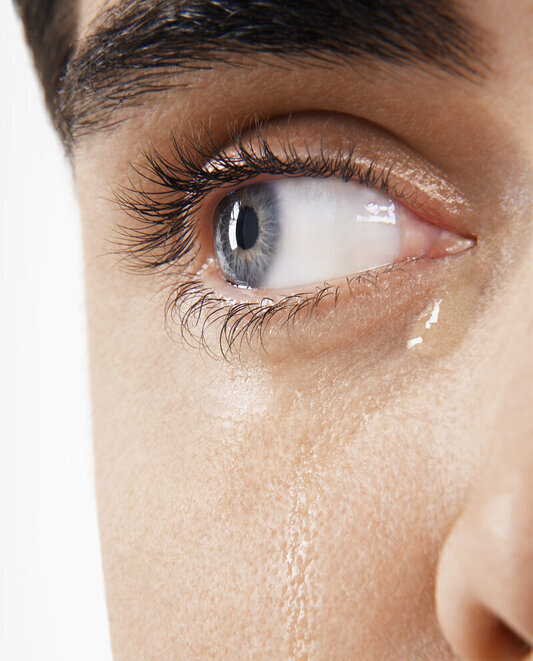Posted by: Atlantic Eye Institute in Education

We think of tears as the watery drops that exit the eye when we cry, enjoy a good laugh, or when something gets in our eye. However, our tears are produced and spread over the eye with virtually every blink. Without them, our eyes would dehydrate and become dysfunctional.
5 Facts About Our Tears
In addition to protecting our eyes, tears also serve an emotional and psychological purpose. Read on to learn amazing facts about your tears and why they are so essential to eye health and overall wellbeing.
Our tears have three different layers
What appears to be a single drop of salty (saline) water is actually comprised of three separate layers. Physiologically speaking, tears are very similar to saliva because they contain metabolites, electrolytes, enzymes, and lipids (fats). These are divided into three different layers:
- Inner-mucous layer. This helps connect the tear to the eye so you aren’t constantly shedding tears with each blink of the eye.
- Middle-watery layer. The middle layer is mostly water. It’s the thickest of the three tear layers and works to hydrate your eye, repel environmental particulates, and protect the delicate cornea.
- Outer-oily layer. The outermost layer of our tears keeps tears smooth and glossy so we can see through them. It also projects the watery layer by slowing down the rate of tear evaporation.
There are three different types of tears
When it comes to tear production, our bodies are programmed to produce three different types, depending on the situation and certain catalysts.
- Basal tears. Basal tears are every day, all-day lubricants consistently produced and spread across and around the eye when you blink. When you suffer from dry eye, you’re suffering from a deficiency in basal tear quality or quantity. In addition to general hydration, basal tears are your eyes’ first line of defense against environmental contaminants like dust and small debris.
- Reflex tears. Wherever you have that irritating, “there’s something in my eye,” feeling, your eyes begin producing reflex tears. And, what a quick reflex it is. Within milliseconds of sensing contaminants too big to shed with a regular blink, tear ducts jump into action, flushing the eyes with reflex tears to help evacuate the offender(s). Reflex tears are also activated by the presence of strong fumes or other irritants, such as strong raw onions or smoke.
- Emotional tears. These special tears activate when humans (and some animals) experience strong emotions, such as joy, sadness, or fear. And, as we’ll expand on below, many scientists believe these tears are a way for the body to excrete hormones and chemical byproducts of those emotions, providing a physical, emotional, and mental release.
The journey tears – from start to finish
Tears originate from a specialized place called the lacrimal glands, which are located above each eye. Tears are evenly spread across and around the eyeball each time you blink, maintaining consistent moisture and lubrication levels. Some of this moisture evaporates into the environment. The leftover tears drain via very small holes, called the puncta, located at the inner corners of the lower and upper eyelids.
You can see the lower eyelid puncta when you look in the mirror. Sometimes, the puncta, also called the tear duct, gets clogged, which causes uncomfortable redness and swelling. Eye swelling or eye injuries also cause blocked tear ducts, which typically resolve independently.
Residual basal tears or a small quantity of reflex or emotional tearing drain from the puncta and through small canals located on the undersides of your eyelids. These canals drain into the sinus cavity and empty in your nose, where they are typically dried up or absorbed. When the eye produces more reflex or emotional tears than the puncta and sinuses can handle, they overflow and run down your cheeks (or via a runny nose).
Tear production slows down as we age
As we age, the body produces fewer tears. This is why dry eye is more prevalent in older populations. Or, we should say, it used to be more prevalent in the older population. Unfortunately, our screen-based culture makes younger people more prone to dry eye. If you use screens daily, take proactive action to protect your tears by taking regular breaks and consciously blinking to hydrate and lubricate the eyes.
Other things that can hinder or harm tear production include:
- Wearing contact lenses
- Not getting enough sleep
- Becoming dehydrated
- Medication side effects
The psychology of emotional tears
The body is a highly-efficient machine, so healthy bodies don’t waste energy producing anything they don’t need. That said, like sleep, the “why” of emotional tears has been a subject of much thought and inquiry in the scientific and healthcare communities.
According to psychcentral.com:
Emotional tears are chemically different than basal and reflex tears. All tears contain enzymes, lipids, electrolytes, and metabolites. However, emotional tears appear to contain additional proteins and hormones. Preliminary research has shown that emotional tears may have increased levels of prolactin, potassium, manganese, leu-enkephalin, and adrenocorticotropic hormones. The release of these hormones and elements during emotional crying helps regulate stress levels in the body and return it to a more balanced state.
So, while it may not be “socially acceptable” to cry, make time to feel and express your emotions. Letting the tears flow is another way your lifestyle choices can support overall health and wellbeing – including eye health.
Are you due for an optometrist appointment? Or, do you have concerns about lack of natural tears or eye irritation? Contact us here at the Atlantic Eye Institute and schedule an appointment. We offer Virtual Exams, which make it easy to review your symptoms and concerns to determine whether an in-person appointment is necessary.



